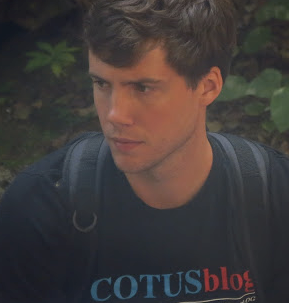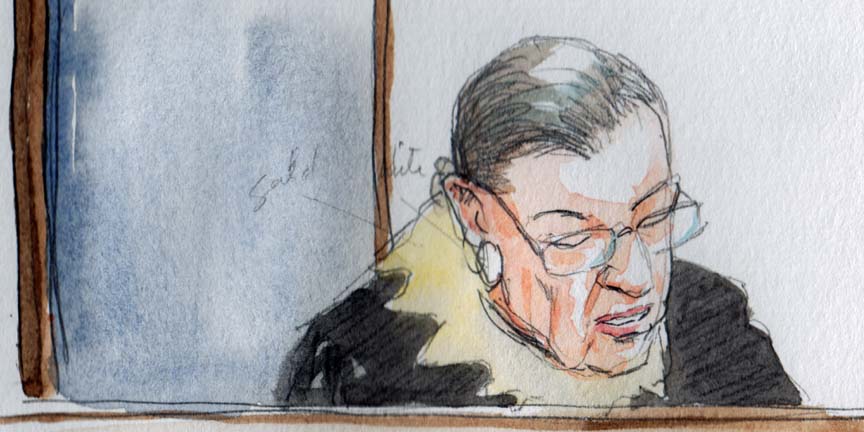More on Marshall – according to Ginsburg

on Oct 30, 2017 at 10:09 am

Two weeks ago, Justice Elena Kagan called Justice Thurgood Marshall “the greatest lawyer of the 20th century.”
Here’s another one for the folks at Guinness: Justice Ruth Bader Ginsburg is the “most important woman lawyer in the history of the republic,” doing for women’s rights what Marshall did for the rights of people of color, said Judge Ann Claire Williams yesterday. Williams was quoting from President Jimmy Carter’s speech nominating Ginsburg to the U.S. Court of Appeals for the District of Columbia Circuit.

Justice Ginsburg (Art Lien)
Speaking with Ginsburg yesterday before an audience of young lawyers and law students at a conference sponsored by Equal Justice Works, Williams, a judge on the U.S. Court of Appeals for the 7th Circuit, had just outlined Ginsburg’s advocacy in six major Supreme Court cases.
After Ginsburg described her reaction to the nomination – “I never thought becoming a judge was possible” — the justice clarified what she sees as a crucial distinction between her and Marshall.
“When Marshall was in a southern town, he didn’t know if he would be alive at the end of the day,” Ginsburg said. “My life was never in danger, so there’s an enormous difference.”
Ginsburg did offer that Marshall had “a winning technique, and we copied it” at the Women’s Rights Project of the American Civil Liberties Union. This technique involved “leading the court where you want to go, not with giant steps but taking things one step at a time.”
As Ginsburg explained, for nearly 20 years Marshall did not directly attack “separate but equal,” the doctrine from the 1896 case Plessy v. Ferguson that upheld the constitutionality of racial segregation. Instead, Marshall argued that the separate facilities at issue in various cases were simply unequal. For example, he mounted a successful challenge to the segregated law schools in Maryland (in the Maryland Court of Appeals case Murray v. Pearson). Only after “building blocks” like this one were in place did Marshall argue in Brown v. Board of Education that, as the Supreme Court held in that case, “[s]eparate educational facilities are inherently unequal.”
In confronting sex-based discrimination, Ginsburg borrowed Marshall’s technique of incremental steps by focusing first on discrimination’s negative consequences for men. For instance, in Weinberger v. Wiesenfeld, Ginsburg represented a widower challenging a provision of the Social Security Act that permitted widows but not widowers to collect special benefits while caring for minor children. Ginsburg emphasized that although the discrimination in Weisenfeld’s case “began with the attitude toward women” — the idea that they were caretakers and men were earners — “this hurts everybody” – both the man who has to work full-time and the child who loses a more involved parent.
“Let me give a big plug to Jimmy Carter,” Ginsburg said, returning to the president who first nominated her to the judiciary. According to Ginsburg, Carter in the 1970s recognized that the nation’s judges – primarily white men – did not reflect the demographic make-up of the United States. Carter intentionally nominated women and members of minority groups to federal judgeships and “literally changed the complexion of the federal judiciary.”
Later in the conversation, Williams returned to a claim Ginsburg has made in earlier interviews that she will be satisfied only when there are nine women on the Supreme Court. Ginsburg said that “it sounds extreme until you think that for most of history there were nine men serving.”
One law student asked Ginsburg whether there were any opinions that she wished were more widely read. Ginsburg replied that Judge Edward Tamm, her colleague on the D.C. Circuit, had advised her early in her judicial career: “When the opinion is released, don’t look back, go on to the next one, be a forward-looking person.”
A follow-up question by a different student contained the only the only hint of criticism in an afternoon that largely celebrated Ginsburg – replete with humorous references to her nickname (“Notorious RBG”), her workout routine, and an upcoming movie about her. The student expressed disappointment in Ginsburg’s majority opinion in City of Sherrill v. Oneida Indian Nation of New York, in which the court ruled against claims of tribal exemption from property taxes over certain land.
Was Ginsburg’s joining of Justice Sonia Sotomayor’s dissent in a later case, Adoptive Couple v. Baby Girl, in which Sotomayor argued for a stronger interpretation of the Indian Child Welfare Act, “your moving forward to rectify something of the past,” the student asked?
Without addressing the Oneida case, Ginsburg replied that when “on the losing side, you have to remain hopeful that the court will have another opportunity to do the right thing.” She referenced the nearly-century-old case Abrams v. United States, in which Justice Oliver Wendell Holmes’ dissent in defense of free speech has proven more powerful and lasting than the original holding.
Ginsburg doesn’t expect these future opportunities to be reserved for her successors. Joking that she has now passed the 23-year tenure of Justice Louis Brandeis – which she had once considered a benchmark – she told Williams yesterday that “as long as I can do the job full steam, I will do it.”


